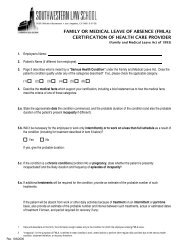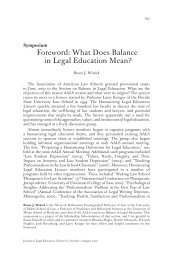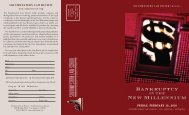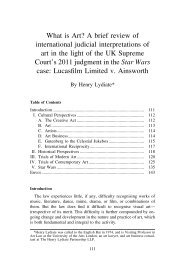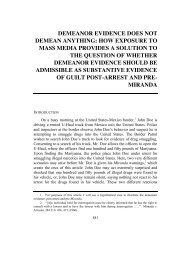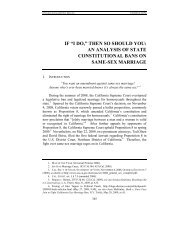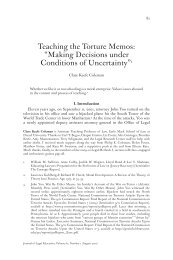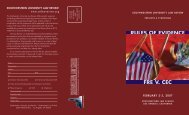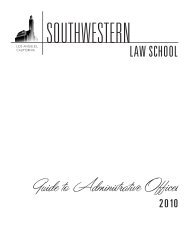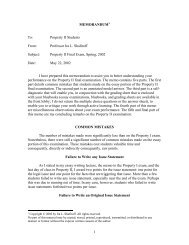An Autobiography of a Digital Idea - Southwestern Law School
An Autobiography of a Digital Idea - Southwestern Law School
An Autobiography of a Digital Idea - Southwestern Law School
Create successful ePaper yourself
Turn your PDF publications into a flip-book with our unique Google optimized e-Paper software.
486 Journal <strong>of</strong> Legal Education<br />
result, both students and pr<strong>of</strong>essors are <strong>of</strong>ten frustrated with their classroom<br />
experiences. 6 Pr<strong>of</strong>essors label their frustration as a war against the laptops,<br />
whereas students consider it a battle against boredom.<br />
Because our students today do not think or learn the way we did when we<br />
were students, 7 it makes no sense to continue to teach them using the same<br />
outdated techniques. Instead, we must modify our pedagogy to meet their<br />
changing needs. However, deciding what to change in teaching is never easy.<br />
Instead <strong>of</strong> fighting technological advances and student preferences, I believe<br />
that law pr<strong>of</strong>essors should learn to bridle the energy and usefulness <strong>of</strong> the<br />
laptop and engage students in the classroom at the students’ technological<br />
level. 8 By expanding our teaching methods to adapt to students’ learning<br />
methods, law pr<strong>of</strong>essors can help students become much more engaged in<br />
the material, resulting in a more active, exciting, and enriching classroom<br />
experience, both for the pr<strong>of</strong>essor and the student.<br />
This is an autobiographical account <strong>of</strong> my attempt to bridge the digital<br />
divide to meet students’ changing needs. When I first began teaching at<br />
Georgetown University <strong>Law</strong> Center in 1993, I employed many traditional<br />
teaching techniques and used printed textbooks. However, laptops soon<br />
began peppering my classroom; at first there were only a few, and then<br />
suddenly almost every student was hiding behind a laptop. I noticed that<br />
my students were looking down at their screens, typing furiously, instead<br />
<strong>of</strong> watching me while I discussed my material written on the blackboard or<br />
projected overhead. When I realized that I was teaching to eyebrows instead<br />
<strong>of</strong> engaging my students eye-to-eye, I concluded that the traditional teaching<br />
methods were no longer effective. In 1999, I decided to research the mindset <strong>of</strong><br />
these new learners, to overhaul my teaching methods and ultimately to create<br />
an interactive, electronic book that could sit conveniently on those laptops in<br />
the classroom.<br />
The electronic book (which took more than eight years to design, write,<br />
build, and test) has transformed the ways in which I teach my students—both in<br />
and out <strong>of</strong> the classroom. It has allowed me to engage students so that they can<br />
reach a high level <strong>of</strong> understanding <strong>of</strong> the material, retain the information and<br />
enjoy the class as well. In this article, I describe the history and pedagogy that<br />
motivated me to write an interactive, electronic book; explain the thinking and<br />
learning process <strong>of</strong> the digital student; detail using the electronic book both in<br />
6. See id.<br />
7. Thomas Keefe, Teaching Taxonomies, 14 Perspectives 153, 156 (2006) (“Our students have<br />
been raised entirely on computers. We must recognize this reality and adjust our teaching to<br />
account for it.”).<br />
8. Some pr<strong>of</strong>essors might argue that this sort <strong>of</strong> change in pedagogy would be “giving in” to<br />
the students’ demands and would not lend itself to a high level <strong>of</strong> learning. See Caron &<br />
Gely, supra note 3, at 556 (describing critics <strong>of</strong> technology in the classroom). However, if we<br />
want to reach our audience (as we teach them to reach their audience as lawyers), we cannot<br />
ignore our audience’s methods <strong>of</strong> thinking, learning, and receiving information. By taking<br />
advantage <strong>of</strong> their learning techniques, we can teach at an even higher level.



